Bonito Adventures
Wild & Wet Bonito -- Adventures in Aquatic Ecotourism
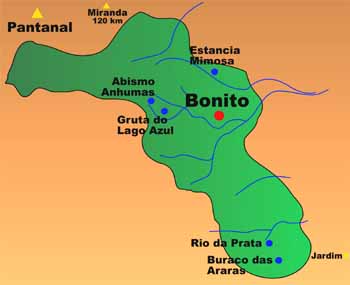 Located south of the Pantanal and close to the border of Boliva and Paraguay, this sleepy town of Bonito is now the center of a thriving ecotourism industry. Unique geologic formations and an abundance of running water provides for several exciting eco-adventures.
Located south of the Pantanal and close to the border of Boliva and Paraguay, this sleepy town of Bonito is now the center of a thriving ecotourism industry. Unique geologic formations and an abundance of running water provides for several exciting eco-adventures.

We were met in Sao Paulo by Ambiental Tours who had arranged all the activities, lodging, transfers and our English-speaking guide. From there we flew to Campo Grande in the east of Moto do Grosso. The four-hour ride to Bonito passed wide expanses of farm and cattle-grazing areas. The late afternoon sun peeked through clouds full of moisture casting soft light across the landscape. Fields red with ferrous soils were dotted at times with three-foot high mounds from termites. A solitary ema, which resembles an ostrich, stood like a statue unaware of our passing, in the warm glow of the evening.
The limestone earth has been eroded, carved and sculpted through millions of years by the action of water. There are more than 500 caves in the region but only a few are accessible to tourists. It was these unique geologic formations that enticed us to explore this area. Several fresh water diving opportunities, including rivers, caverns and water-filled limestone caves have yet to be discovered by scuba adventurers. We were not sure what we would find but we knew that excitement awaited us.
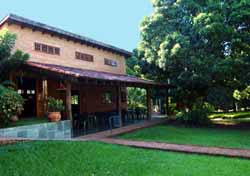
On our drive from Campo Grande to Bonito we were informed by our translator, Ulli, that we were to undergo special training that night for our decent into the Abismo Anhumas. After traveling some 26 hours from California through Houston and Sao Paulo, we were in no position to be trained on the 20-foot high rappel scaffold. We postponed the training and went directly to the Pousada Olho d'Aqua (our hotel) to recover from our journey. Later we went into town for an enjoyable meal of fish in a Brazilian sauce and rice.
Gruta do Lago Azul
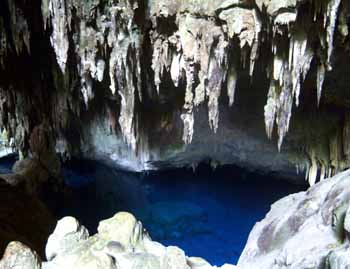 The next day we got up early (as every day thereafter) and went to Gruta do Lago Azul. This turned out to be a spectacular massive cavern with a blue placid lake within. These geologic formations are an experience not to be missed with impressive stalactites, stalagmites and ephemeral lighting.
The next day we got up early (as every day thereafter) and went to Gruta do Lago Azul. This turned out to be a spectacular massive cavern with a blue placid lake within. These geologic formations are an experience not to be missed with impressive stalactites, stalagmites and ephemeral lighting.
We entered the Blue Grotto by going down natural stone steps carved into the forest. There we were surrounded by immense formations of stalactites hanging from the cave's walls and ceiling. We descended into the dark cave and the sunlight from above lit up strange and wonderful shapes that looked like aliens and giant animals. Then as we went deeper, a bright blue speck of water appeared between the stalactites and grew into a beautiful reflective pond with a shoreline that tempted entry but was forbidden. Each turn unveiled more ageless formations.
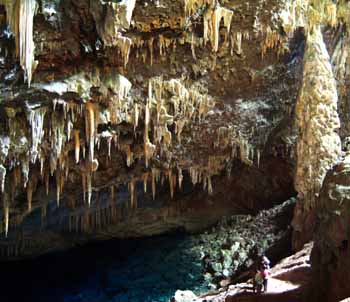 The light from the cavern's mouth faded as a storm approached. As we ran back up the steps in the pelting rain, I nearly stepped on a massive toad that looked just like the surrounding rocks.
The light from the cavern's mouth faded as a storm approached. As we ran back up the steps in the pelting rain, I nearly stepped on a massive toad that looked just like the surrounding rocks.
We waited for the storm to pass in Bonito by having lunch and doing some shopping. The rain persisted so we decided that the only thing to do in a town without a cinema was a wet hike to check out the flow of the waterfalls.
Estancia Mimosa
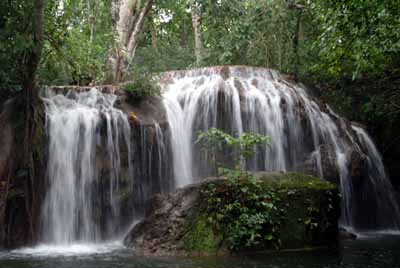 We drove 24 km north from Bonito to a protected area that affords several hiking trails. The trail through the riverside forest of the Mimoso River is home to many birds and mammals that live within limestone caves and under waterfalls. The forest is thick with ferns, orchids, bromeliads and ancient trees.
We drove 24 km north from Bonito to a protected area that affords several hiking trails. The trail through the riverside forest of the Mimoso River is home to many birds and mammals that live within limestone caves and under waterfalls. The forest is thick with ferns, orchids, bromeliads and ancient trees.
The warm rains continued all afternoon, broken by periods of bright sunshine. The forest easily absorbed the rain so the hiking was not difficult. Organized tours are conducted daily but as it was raining, we had the forest to ourselves.
We passed several of the eight waterfalls as we climbed high for the vistas and descended deep into the forest for the swimming pools. The day's raining filled the river and the waterfalls babbled loudly. Each pool tempted us and finally we put away our cameras, removed our wet outer garments and plunged into the inviting waters.
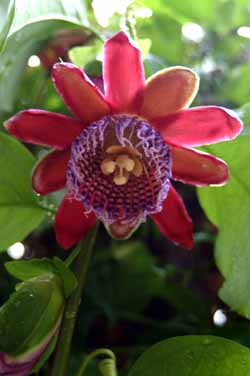 The water that drains the limestone areas of Bonito are rich in calcium carbonate. Leaves and other organic materials settle to the bottom of streams and ponds giving the water a slightly brackish color and taste. Algae and moss mixed with the fine carbonate sediment grow into long strands that hang from the quiet corners of the waterfalls. Several of the ponds have massive mossy areas dripping with water. We dove under the water to emerge behind the waterfall and peered out from these fairyland caves. We ran from waterfall to waterfall. gleefully diving in the warm waters to explore the caves behind them.
The water that drains the limestone areas of Bonito are rich in calcium carbonate. Leaves and other organic materials settle to the bottom of streams and ponds giving the water a slightly brackish color and taste. Algae and moss mixed with the fine carbonate sediment grow into long strands that hang from the quiet corners of the waterfalls. Several of the ponds have massive mossy areas dripping with water. We dove under the water to emerge behind the waterfall and peered out from these fairyland caves. We ran from waterfall to waterfall. gleefully diving in the warm waters to explore the caves behind them.
Back at the farmhouse, we were offered snacks and hot drinks as we began to dry out from our water-logged afternoon hike. The tours usually offer food cooked on a potbelly stove followed by regionally sweets. Our first day in Bonito has been filled with wondrous sights and the frequent sounds of the nearby Toucans.
Rio da Prata
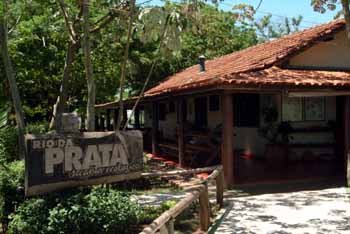 There are four rivers to the south of Bonito, each with different water activities. One of the better known tours is the fish encounter in the Rio da Prata. This is a protected area with freshwater snorkeling and if the visibility is good, tank diving.
There are four rivers to the south of Bonito, each with different water activities. One of the better known tours is the fish encounter in the Rio da Prata. This is a protected area with freshwater snorkeling and if the visibility is good, tank diving.
We drove to the ecological refuge and were served a buffet-style lunch in the grassy area next to the river. After being fitted for wet suit and mask, we went up stream to start the drift snorkel. Once in the water we discovered an underwater world quite different from anything we had experienced in the ocean.
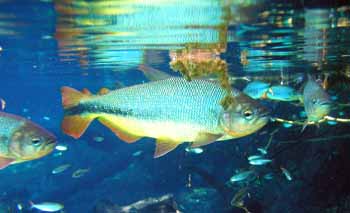 The pond we entered first, had floating water lilies over a sandy bottom. The water is generally crystal clear but since it had be raining, the visibility was somewhat reduced. Still clear, we swam with several species of freshwater fish including dourados, piraputangas, pinatados and corimbas. The names of these Brazilian fish I had not heard before but many resembled catfish, carp and trout. They were very friendly letting us get close to photograph them. On the sandy bottom we found the bleached-white bones of an anteater that had drowned and boiling pots where cold ground water percolated up to the stream.
The pond we entered first, had floating water lilies over a sandy bottom. The water is generally crystal clear but since it had be raining, the visibility was somewhat reduced. Still clear, we swam with several species of freshwater fish including dourados, piraputangas, pinatados and corimbas. The names of these Brazilian fish I had not heard before but many resembled catfish, carp and trout. They were very friendly letting us get close to photograph them. On the sandy bottom we found the bleached-white bones of an anteater that had drowned and boiling pots where cold ground water percolated up to the stream.
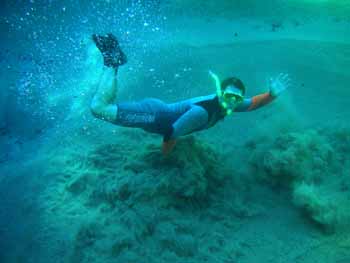 The river ran fast and floating in our buoyant wet suits on the surface, we navigated past boulders and fallen trees to the next pool of resident fish. Soon it became quite exciting as our speed increased. We caught ourselves right before the rapids and sloshed along the trail to enter the river again below them. We soon merged with the main branch of the river which is much wider and deeper. Here scuba diving is possible when the water is clearer.
The river ran fast and floating in our buoyant wet suits on the surface, we navigated past boulders and fallen trees to the next pool of resident fish. Soon it became quite exciting as our speed increased. We caught ourselves right before the rapids and sloshed along the trail to enter the river again below them. We soon merged with the main branch of the river which is much wider and deeper. Here scuba diving is possible when the water is clearer.
It was a long snorkel ride and very beautiful. This freshwater experience is very different from ocean diving, quite exhilarating fun and very interesting.
Buraco das Araras
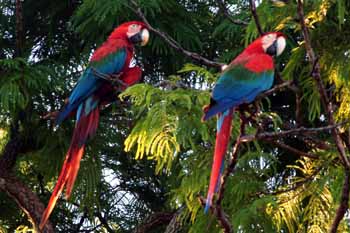 Before returning to Bonito, we visited Buraco das Araras, an area with a large resident flock of Macaws. Late in the day, the Macaws congregate in the trees that ring a deep sinkhole with a murky green pond below. There are several viewing areas that ring the sinkhole. The airways are alive with the squawks of parrots, herons and the Southern Screamer.
Before returning to Bonito, we visited Buraco das Araras, an area with a large resident flock of Macaws. Late in the day, the Macaws congregate in the trees that ring a deep sinkhole with a murky green pond below. There are several viewing areas that ring the sinkhole. The airways are alive with the squawks of parrots, herons and the Southern Screamer.
 The 1864-70 Paraguayan War, fought between Paraguay and the allied countries of Argentina, Brazil, and Uruguay, was the bloodiest conflict in Latin-American history. The dictator of Paraguay, Francisco Solano Lopez, believing that the regional balance of power was threatened, went to war with Brazil. His 50,000-man army was the strongest in Latin America. Argentina and Uruguay soon joined the fight.
The 1864-70 Paraguayan War, fought between Paraguay and the allied countries of Argentina, Brazil, and Uruguay, was the bloodiest conflict in Latin-American history. The dictator of Paraguay, Francisco Solano Lopez, believing that the regional balance of power was threatened, went to war with Brazil. His 50,000-man army was the strongest in Latin America. Argentina and Uruguay soon joined the fight.
At the opening of the war Paraguayan forces advanced northward into the Brazilian province of Mato Grosso. Logistical problems and the buildup of Brazilians soon out numbered them 10 to 1. Of the 525,000 people in prewar Paraguay, only 221,000 were left in 1871 and only 28,000 were men. It is rumored that thousands may have been fed to the waiting caiman crocodiles at the bottom of the Buraco das Araras sinkhole.
It was the unique geologic formations found in Bonito that enticed us to explore this area. Several fresh water diving opportunities are available. As we had planned to dive the Atlantic Northeast, we had all the diving and photographic gear necessary to try our hand at fresh water cave diving. We did not realize that to venture deep within the water filled limestone caves required more than open water or even wreck diving training.
We found out that we needed formal training and certification offered by such organizations as the National Speleological Society Cave Diving Section (NSS-CDS) and the National Association for Cave Diving (NACD) in the United States. These certifications are considered technical whereas cavern diving (exploring overhead environments while remaining within sight of their entrances) is considered recreational diving and divers can take specialty courses from NAUI, PADI, SDI and SSI.
Even without diving the enclosed environments of the limestone caves, there are several opportunities to explore the freshwater caverns of Bonito. However, years of ocean diving adventures did not prepare us for what was to follow.
Abismo Anhumas
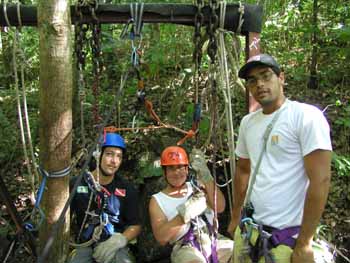 Lynn peered over to me with her normal fear-of-heights look as we dangled from the 20-foot training scaffold. Before venturing into the Abismo, we needed to be checked out with the repelling equipment that would allow us to lower ourselves to the diving platform on the lake's surface below. More importantly, we needed the skills to be able to pull ourselves back up the rope more than 200 feet (72 meters).
Lynn peered over to me with her normal fear-of-heights look as we dangled from the 20-foot training scaffold. Before venturing into the Abismo, we needed to be checked out with the repelling equipment that would allow us to lower ourselves to the diving platform on the lake's surface below. More importantly, we needed the skills to be able to pull ourselves back up the rope more than 200 feet (72 meters).
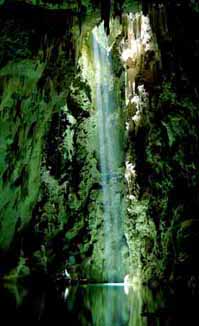 The trip was planned to make optimum use of the little sunlight that streamed from the cavern's roof. All of our gear was neatly packed into waterproof bags and lowered to the platform. We were next. Ulli and I lowered ourselves through the narrow opening and slid slowly past the cool damp rocks. Once within the main cavern, the repel was easy and fast as I quickly landed on the platform. Lynn followed soon after. She was nervous and excited but pacified by the assistance of a well-trained guide.
The trip was planned to make optimum use of the little sunlight that streamed from the cavern's roof. All of our gear was neatly packed into waterproof bags and lowered to the platform. We were next. Ulli and I lowered ourselves through the narrow opening and slid slowly past the cool damp rocks. Once within the main cavern, the repel was easy and fast as I quickly landed on the platform. Lynn followed soon after. She was nervous and excited but pacified by the assistance of a well-trained guide.
Standing on the floating platform, a wondrous world presented itself. From the opening in the ceiling, an intense beam of sunlight illuminated a small area of the lake's surface. The light was so bright that the entire cavern shimmered with its reflections.
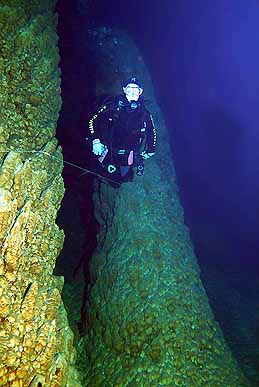 Stalactites hung all around and interesting rock formations were etched into the cave walls. It was warm, dark and cozy down there. The guides' work was jovial and friendly as we changed into our scuba gear. The atmosphere was intimate and exciting.
Stalactites hung all around and interesting rock formations were etched into the cave walls. It was warm, dark and cozy down there. The guides' work was jovial and friendly as we changed into our scuba gear. The atmosphere was intimate and exciting.
We entered the dark cold water (68F) and checked our gear and cameras. We slipped past a large cauliflower speleotheme in the cavern's shallows. As we descended into the deep, a magical world of towering stalagmites emerged. It was another world, quite unlike the ocean, devoid of anything much but the cones which jutted up in all sizes.
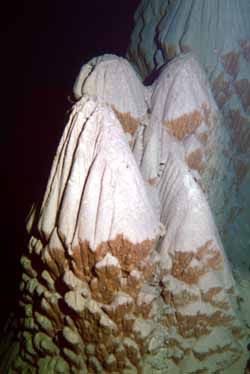 This surreal landscape in the dark was both eerie and wondrous.
This surreal landscape in the dark was both eerie and wondrous.
There some 20 cones within the lake. The maximum depth of the lake is 135 feet but our dive was limited to 85. At this depth the bleached bones of an anteater that had fallen from above, lay perfectly arranged in the sand. Our dive guide led us around and through several impressive cones. We were in the water nearly 40 minutes but the excitement prevented the cold from getting to me. I knew that there was a limit to my bladder as we were strictly instructed for environmental reasons "not to go" in the water.
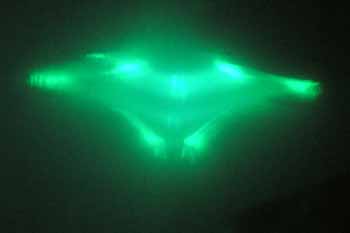 In the distance between two towering cones, a strange shape appeared in the water. As we approached, light from above streamed in creating an other-worldly glow. The bright green diamond shape appeared like an alien spacecraft hovering just below the surface. The intense beam of sunlight from the world above created a sight unlike anything I had ever experienced.
In the distance between two towering cones, a strange shape appeared in the water. As we approached, light from above streamed in creating an other-worldly glow. The bright green diamond shape appeared like an alien spacecraft hovering just below the surface. The intense beam of sunlight from the world above created a sight unlike anything I had ever experienced.
Back on the landing, we changed into warm clothes and took the dinghy past a small colony of Vampire bats, where we climbed onto the land at the cavern's edge. On land surrounded by large rocks, we tried to capture the beauty of our surroundings using available light. We were very privileged to be able to experience such a beautiful place.
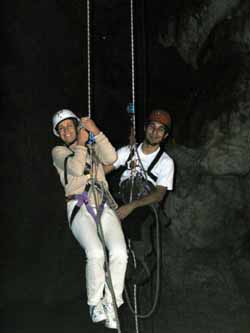 All of our gear had been safely pulled to the surface. It was now time to start our accent out of the cave. Lynn went first along with her guide to ease her fear of heights. I watched her "frog" herself up the rope. It generally takes about 25 minutes to climb the 210 feet to the surface. However, our guides can race up in under 4 minutes because they make as many as three trips per day. Some climbers take more than an hour and others have to be pulled out.
All of our gear had been safely pulled to the surface. It was now time to start our accent out of the cave. Lynn went first along with her guide to ease her fear of heights. I watched her "frog" herself up the rope. It generally takes about 25 minutes to climb the 210 feet to the surface. However, our guides can race up in under 4 minutes because they make as many as three trips per day. Some climbers take more than an hour and others have to be pulled out.
It was my turn. I started up the rope and soon stopped to rest my arms. As I inched up the rope, I soon hovered nearly 100 feet above the water. Trusting my climbing gear, I leaned back, dangling on the rope, to absorbed the immense beauty of the subterranean world.
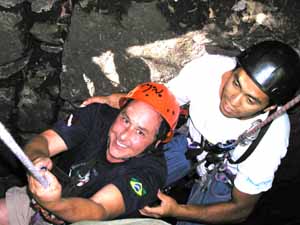 The last rays of sunlight were leaving the cave as I inched up through the narrow upper section. After 19 minutes I emerged happy to be out of this dark hole.Would I do it again? You bet I would!
The last rays of sunlight were leaving the cave as I inched up through the narrow upper section. After 19 minutes I emerged happy to be out of this dark hole.Would I do it again? You bet I would!
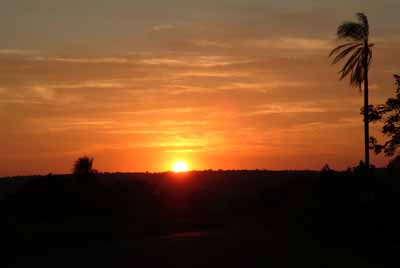 We returned to Olho d' Aqua pousada to clean our gear and enjoy some Brazilian barbecue. The days we spent in Bonito were filled with sights, sounds, good food and excitement. As we drove north to the Pantanal, we were treated to another brilliant Brazilian sunset. A Red-Legged Seriema, larger than a wild turkey, darted across our path and into the brush. We were almost too tried to notice or even to wonder what was in store for us next.
We returned to Olho d' Aqua pousada to clean our gear and enjoy some Brazilian barbecue. The days we spent in Bonito were filled with sights, sounds, good food and excitement. As we drove north to the Pantanal, we were treated to another brilliant Brazilian sunset. A Red-Legged Seriema, larger than a wild turkey, darted across our path and into the brush. We were almost too tried to notice or even to wonder what was in store for us next.
For more information, visit our Brazil Resources page.
